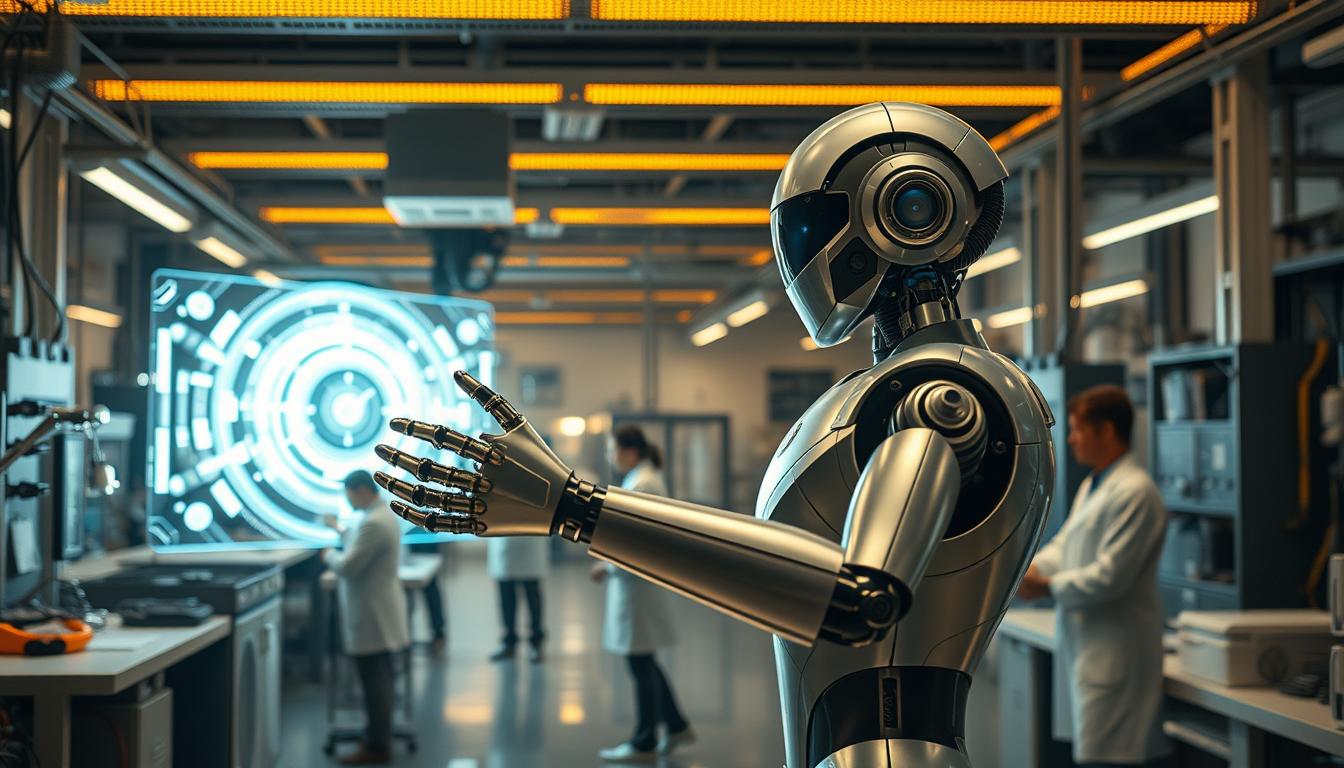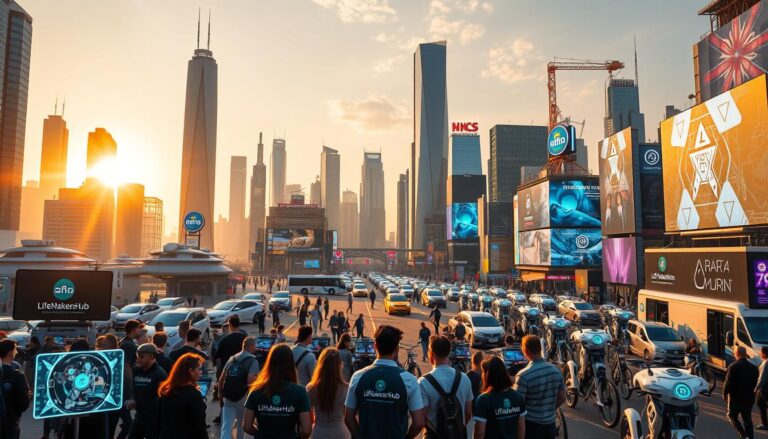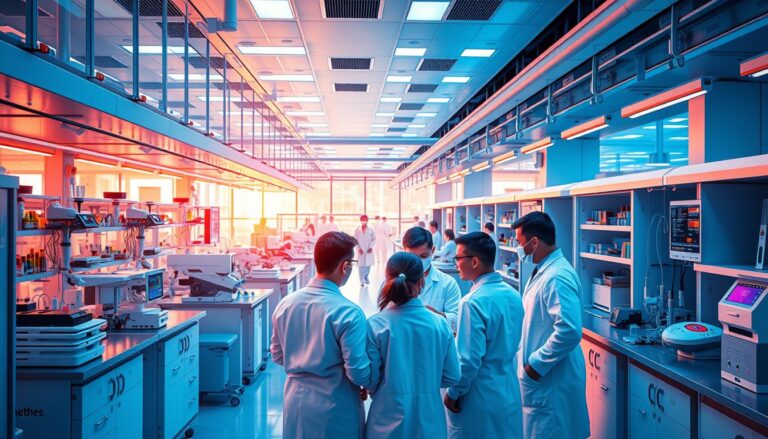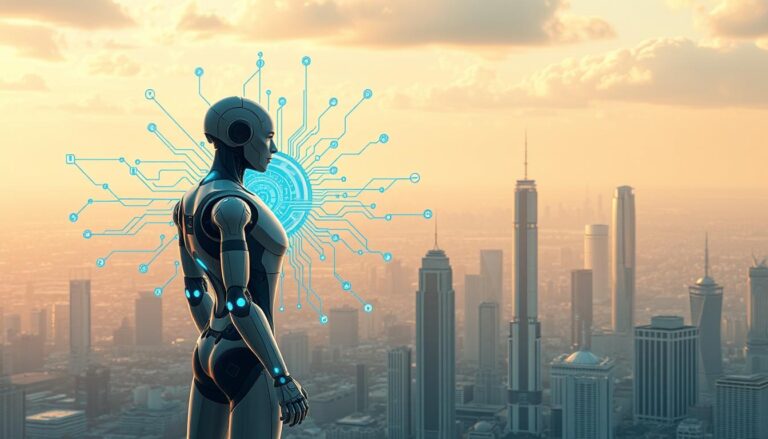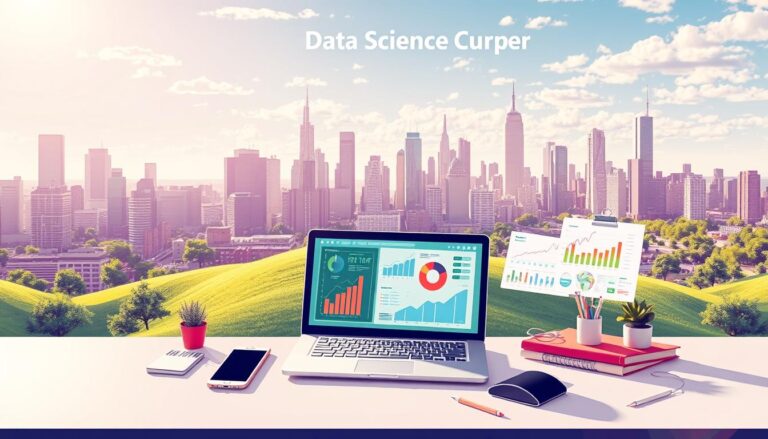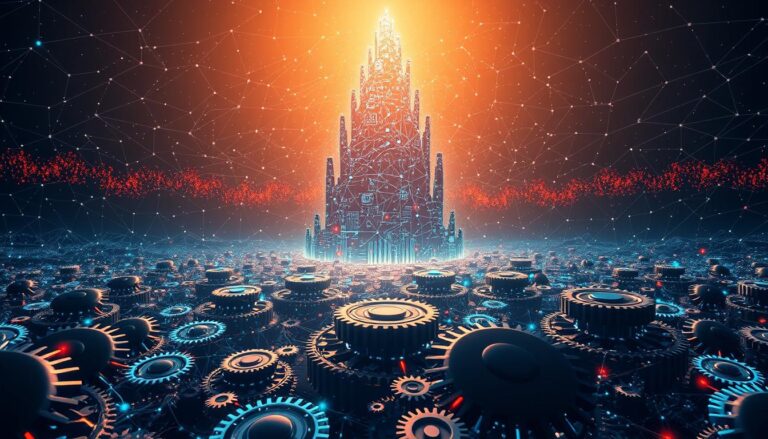Discover the Latest Advancements in Robotics
Robotics is transforming the way we live and work. From Mars rovers to industrial applications, robots are pushing the boundaries of what’s possible. These machines combine mechanical, electrical, and software engineering to solve complex problems and perform tasks once deemed too dangerous or repetitive for humans.
Recent breakthroughs highlight the versatility of robots. For example, bioinspired designs are enabling machines to adapt to challenging terrains, while collaborative robots are filling gaps in skilled labor. These advancements are not just about technology—they’re about improving efficiency and safety for people worldwide.
As we explore the latest innovations, we’ll dive into how control systems and human-centric designs are shaping the future of robotics. Whether it’s in space exploration or everyday industries, robots are proving to be indispensable tools for progress.
Key Takeaways
- Robots are revolutionizing industries with their versatility and efficiency.
- Breakthroughs in bioinspired designs are enhancing adaptability.
- Collaborative robots are addressing skilled labor shortages.
- Control systems are critical for precision and performance.
- Human-centric designs ensure robots meet real-world needs.
Introduction to the Advancements in Robotics
From factories to hospitals, machines are reshaping industries with precision and efficiency. This technology has evolved from simple mechanical arms to complex systems capable of performing intricate tasks. The integration of science, engineering, and advanced software has unlocked new possibilities for automation.
One notable example is the Unimate, the first industrial robot installed in 1961. It revolutionized manufacturing by handling repetitive tasks with unmatched accuracy. Today, robots are used in diverse applications, from assembling cars to assisting in surgeries. The Da Vinci Surgical System, for instance, enables minimally invasive procedures with enhanced precision.
In agriculture, robots are transforming how we work. Automated harvesters and drones monitor crops, increasing efficiency and reducing labor costs. These applications highlight how technology is addressing real-world challenges. From manufacturing to healthcare, robots are proving to be indispensable tools.
As we explore these advancements, it’s clear that technology is driving innovation across sectors. Whether it’s improving productivity or enhancing safety, robots are at the forefront of progress. Their ability to solve complex problems continues to redefine what’s possible.
The Evolution of Robotics Technology Over Time
From Leonardo’s early designs to modern autonomous systems, robotics has come a long way. What started as simple mechanical automata has evolved into machines capable of performing complex tasks and interacting with the world in meaningful ways.
In the 1920s, the term “robot” was first introduced in Karel Capek’s play RUR. This marked the beginning of our fascination with machines that could mimic human actions. Fast forward to 1954, and the Unimate became the first industrial robot, revolutionizing manufacturing by handling repetitive tasks with precision.
By the 1960s, the Shakey robot emerged as the first mobile machine, showcasing the potential for autonomy. These milestones paved the way for robots to move beyond factories and into diverse fields like healthcare, agriculture, and space exploration.
Today, robots are designed to adapt to their environment, much like humans. They can navigate challenging terrains, assist in surgeries, and even collaborate with people in shared workspaces. This evolution reflects our ongoing quest to create machines that enhance efficiency and safety.
As we look back, it’s clear that each breakthrough has built on the last, shaping the way robots perform tasks and interact with the world. From early automata to cutting-edge systems, the journey of robotics is a testament to human ingenuity and technological progress.
Fundamentals of Robotic Systems: Mechanical, Electrical, and Software Components
At the heart of every machine lies a combination of mechanical, electrical, and software components. These elements work together to ensure seamless operation and optimal performance. Understanding their roles is essential for designing systems that meet real-world demands.
Mechanical Construction and Design Principles
Mechanical construction forms the physical backbone of any system. For example, articulated arms provide flexibility and precision in handling tasks. Caterpillar tracks, often used in rugged environments, enhance stability and mobility.
Design principles focus on durability and adaptability. Engineers use precise datum points to ensure accuracy in assembly. This attention to detail allows machines to navigate challenging terrains and perform complex operations with ease.
Electrical Innovations and Power Supply Solutions
Electrical systems are the lifeblood of modern machines. Efficient power supplies, like advanced batteries, ensure consistent performance. These innovations reduce downtime and extend operational time.
Backup solutions, such as uninterruptible power supplies (UPS), are critical for mission-critical applications. They provide reliability, even during unexpected outages. By integrating these technologies, engineers create systems that are both powerful and dependable.
From mechanical design to electrical efficiency, these components work in harmony. Together, they form the foundation of systems that push the boundaries of what’s possible.
Advanced Control Systems and Autonomous Operations
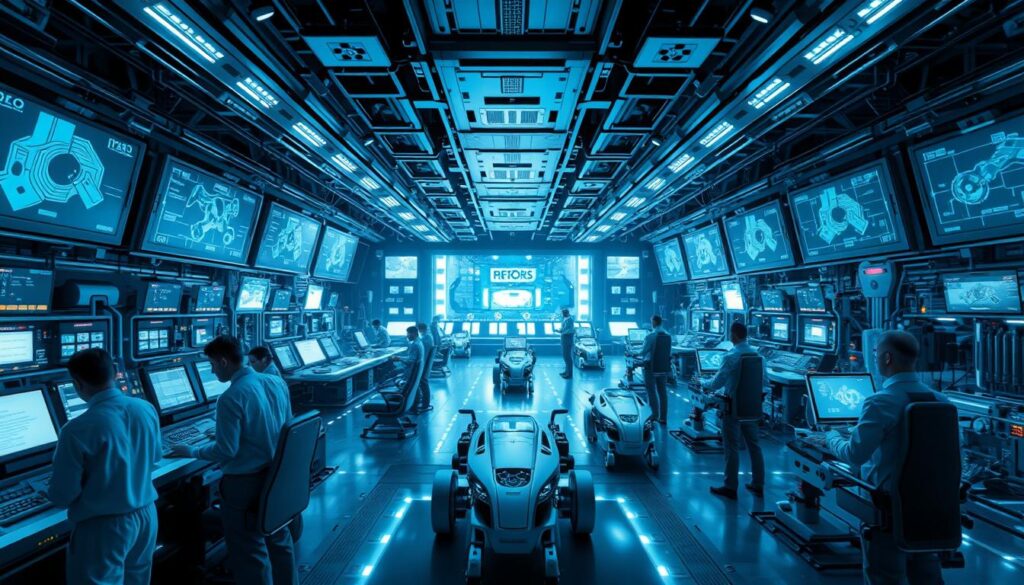
Advanced control systems are redefining how machines operate autonomously in complex environments. These systems rely on sensor integration and feedback mechanisms to ensure precision and adaptability. By combining these elements, machines can perform tasks with minimal human intervention, making them a vital part of modern industry.
Sensor Integration and Feedback Mechanisms
Sensors act as the eyes and ears of autonomous systems. They collect data from the environment, such as temperature, distance, or obstacles. This information is then processed through feedback loops to adjust actions in real time. For example, in space exploration, sensors help rovers navigate rocky terrains and avoid hazards.
Feedback mechanisms ensure that systems can correct errors on the fly. This is crucial in applications like autonomous vehicles, where split-second decisions can prevent accidents. By integrating these technologies, machines become more reliable and efficient.
Artificial Intelligence in Robotic Decision-Making
AI algorithms are the brains behind autonomous operations. They analyze data from sensors and make decisions based on predefined rules or learned behaviors. In complex tasks, such as assembling parts in a factory, AI ensures precision and consistency.
In industry, AI-powered systems are transforming workflows. For instance, in manufacturing, robots can identify defects in products and adjust processes accordingly. This not only improves quality but also reduces waste.
AI also plays a critical role in space missions. Autonomous probes use AI to analyze planetary surfaces and decide where to collect samples. This capability reduces the need for constant human oversight, enabling exploration in remote and hostile environments.
- Sensors and feedback loops are essential for precise control systems.
- AI algorithms enable machines to make autonomous decisions in complex scenarios.
- Advanced control technologies are reshaping industries like manufacturing and space exploration.
- Real-time video demonstrations highlight the effectiveness of these systems.
- These innovations are paving the way for machines to operate in diverse and challenging environments.
Industrial Robotics and Automated Manufacturing
The manufacturing landscape is undergoing a seismic shift with the rise of automated systems. These innovations are not just enhancing efficiency—they’re redefining how we approach production. From assembly lines to quality control, machines are setting new benchmarks for precision and speed.
Researchers have played a pivotal role in developing machines capable of high-level performance. For instance, automated factories—often referred to as “lights off” facilities—operate without human intervention. These setups rely on advanced systems to maintain order and consistency, even in complex tasks.
In the automotive sector, robots are transforming workflows. They handle tasks like welding, painting, and assembly with unmatched accuracy. This not only boosts productivity but also ensures safety in hazardous environments. The integration of these systems has made manufacturing more adaptable to changing demands.
Current trends point toward a future where automation becomes even more seamless. Collaborative systems, designed to work alongside humans, are gaining traction. These machines are equipped with safety features like sensors that detect human presence, ensuring smooth operations.
Looking ahead, the focus is on creating systems that are both intelligent and sustainable. For example, robotic blacksmithing offers a resource-efficient alternative to traditional methods. By reducing waste and energy consumption, these innovations are paving the way for greener manufacturing practices.
In summary, industrial automation is not just about replacing manual labor—it’s about enhancing capabilities. By bringing order to complex processes, these systems are shaping the future of manufacturing. As technology evolves, the possibilities for innovation are endless.
Humanoid Robots and Collaborative Innovations
Humanoid robots are stepping into the spotlight, blending advanced technology with human-like capabilities. These machines mimic human actions and appearance, making them ideal for tasks that require precision and adaptability. From assisting in manufacturing to enhancing workplace safety, their development is reshaping industries.
Collaborative robots, or cobots, are designed to work alongside humans. They enhance productivity by taking on repetitive or hazardous tasks. For example, in manufacturing, cobots like Moxie integrate with electronic healthcare records to perform non-clinical tasks efficiently. This capability ensures smoother workflows and safer environments.
Modern humanoid systems are equipped with advanced learning functionalities. These allow them to adapt to new tasks and environments. For instance, RoMan, a military robot, uses deep learning algorithms to identify obstacles and hazards in real time. This development highlights the potential for humanoid robots to operate in diverse settings.
These innovations foster improved action-oriented collaboration between humans and machines. By combining human creativity with robotic precision, we can achieve unprecedented levels of efficiency. As technology evolves, the possibilities for human-machine interactions continue to expand.
| Feature | Humanoid Robots | Collaborative Robots (Cobots) |
|---|---|---|
| Primary Function | Mimic human actions and appearance | Work alongside humans in shared spaces |
| Key Benefit | Adaptability to complex tasks | Enhanced safety and productivity |
| Example | Atlas by Boston Dynamics | Moxie in healthcare settings |
“The integration of humanoid robots into industries is not just about automation—it’s about creating a synergy between humans and machines.”
Looking ahead, the future of humanoid robots is promising. They are expected to play a larger role in sectors like healthcare, agriculture, and space exploration. By combining learning algorithms with advanced capabilities, these machines will continue to redefine what’s possible.
Applied Robotics in Healthcare, Agriculture, and Space Exploration
From operating rooms to outer space, advanced systems are solving real-world challenges. These innovations are not just about technology—they’re about improving lives and pushing boundaries. Let’s explore how machines are making a difference in healthcare, agriculture, and space exploration.
Surgical and Medical Robotics in Action
In healthcare, machines are transforming surgeries and patient care. The Da Vinci Surgical System, for example, enables minimally invasive procedures with unmatched precision. A recent paper highlights how these systems reduce recovery times and improve outcomes.
In addition, collaborative robots are assisting in hospitals. They handle tasks like transporting supplies and monitoring patients, freeing up medical staff for critical work. This group of innovations is driving a higher rate of adoption in healthcare settings.
Agricultural automation is another area where machines shine. Automated harvesters and drones monitor crops, ensuring optimal growth and reducing labor costs. These systems are becoming essential tools for modern farming.
Space exploration also benefits from robotic deployments. The Astrobees, free-flying robots on the International Space Station, assist with experiments and maintenance. Their ability to operate in harsh environments makes them invaluable for future missions.
As we continue to innovate, the addition of advanced systems will reshape industries. From healthcare to space, these machines are proving their worth in solving complex challenges.
Innovative Robotics: Breakthroughs Transforming Industries
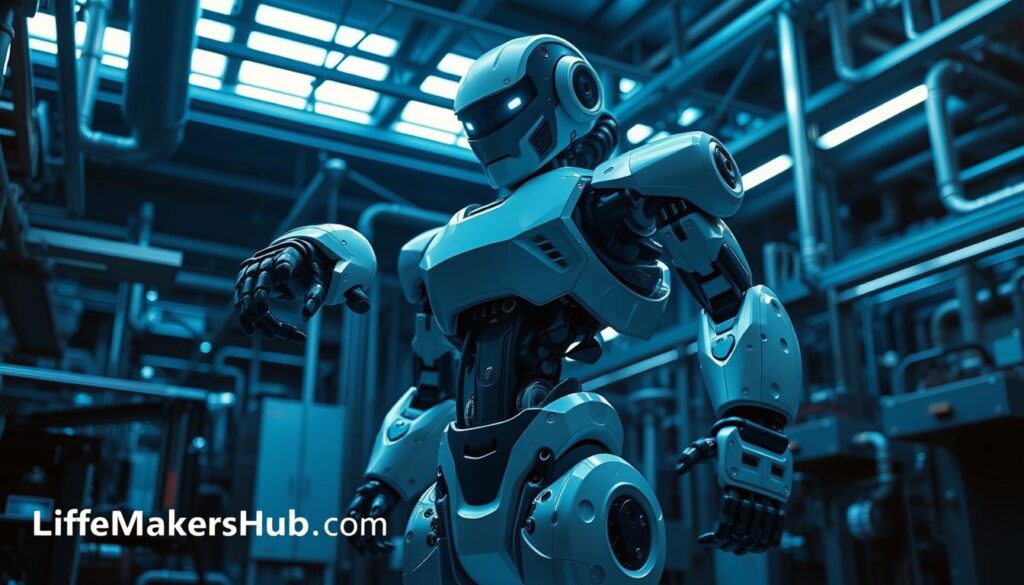
The industrial sector is witnessing a revolution powered by cutting-edge automation. Industrial robots are at the forefront, redefining how tasks are performed in complex environments. These advancements are not just about efficiency—they’re about creating smarter, more adaptable systems.
One of the most significant breakthroughs is the integration of AI into industrial robots. These machines can now analyze data in real time, making decisions that improve precision and reduce errors. For example, in manufacturing, AI-powered systems can identify defects and adjust processes instantly, ensuring higher quality output.
Another key development is the rise of collaborative robots, or cobots. Designed to work alongside humans, cobots enhance productivity while maintaining safety. They are equipped with advanced sensors that detect human presence, ensuring smooth operations in shared environments.
Technological advancements are also transforming industry standards. For instance, modular designs allow industrial robots to be customized for specific tasks. This flexibility ensures that businesses can adapt to changing demands without overhauling their entire system.
Here are some examples of how these innovations are being applied:
- Smart systems in automotive factories handle tasks like welding and painting with unmatched accuracy.
- In agriculture, automated harvesters monitor crops, increasing efficiency and reducing labor costs.
- Healthcare facilities use cobots to transport supplies, freeing up staff for critical tasks.
These breakthroughs are not just improving efficiency—they’re reshaping entire industries. By integrating intelligent systems, businesses can achieve higher productivity, reduce costs, and create safer environments for workers.
As we look to the future, the potential for innovation is limitless. From AI-powered decision-making to modular designs, industrial robots are setting new benchmarks for what’s possible. These advancements are not just transforming industries—they’re shaping the future of work.
Robotics in Everyday Life: Home and Commercial Applications
Robots are no longer confined to factories—they’re now part of our daily lives. From vacuuming floors to assisting in stores, these machines are becoming household staples. They’re designed to handle mundane tasks, making life easier and more convenient.
One of the most popular models is the Roomba, a robotic vacuum cleaner that has been in homes since 2002. It navigates rooms, avoiding obstacles, and ensures floors stay spotless. Similarly, robotic lawn mowers like the Husqvarna Automower take care of yard maintenance, freeing up time for homeowners.
In commercial spaces, robots are enhancing customer service and operations. For example, cobots (collaborative robots) work alongside humans in retail stores, restocking shelves and assisting shoppers. These models are equipped with advanced sensors to ensure safety and efficiency.
Innovations like robotic hands are also making waves. Designed for delicate tasks, these hands can handle fragile objects with precision. For instance, in healthcare, robotic arms assist in surgeries, reducing risks and improving outcomes.
These advancements highlight the balance between high-tech design and practical application. Robots are not just about cutting-edge technology—they’re about solving real-world problems and improving quality of life. From homes to businesses, they’re proving to be indispensable tools for smarter living.
Next-Generation Actuation and Sensor Technologies
The future of movement lies in next-generation actuation and sensor technologies. These innovations are driving precision and adaptability in modern systems, enabling machines to perform tasks with unparalleled accuracy. From electric motors to emerging alternatives like piezoelectric actuators, the design of these components is reshaping how machines interact with their environment.
One of the most significant advancements is the shift toward bio-inspired actuators. These types of components mimic natural muscle functionality, offering high force generation with minimal energy consumption. For example, shape-memory alloys and piezoelectric materials allow actuators to adjust properties based on temperature or electric fields, enhancing responsiveness in real-time applications.
Traditional motors, like electric and linear actuators, are being complemented by innovative alternatives. Piezoelectric actuators, for instance, operate at a microscopic scale, making them ideal for precise tasks in biomedical devices. This evolution in design ensures that systems can adapt to diverse challenges, from delicate surgeries to rugged industrial environments.
Sensor technologies are also advancing rapidly. Magnetic angular position sensors, such as ams’ AS5047P, provide high resolution and repeatable accuracy. These sensors are essential for precise joint movements, ensuring smooth operation in consumer and professional systems. Ultrasonic sensors, while effective, face limitations in range and accuracy, making advanced alternatives like LIDAR and 3D cameras increasingly popular for spatial awareness.
“The integration of next-gen actuators and sensors is not just about technology—it’s about creating systems that move and respond like never before.”
Here’s how these advancements are transforming industries:
- Bio-inspired actuators enable organic-like movements, enhancing precision in tasks like assembly and surgery.
- Piezoelectric materials offer microscopic precision, ideal for biomedical and manufacturing applications.
- Advanced sensors like LIDAR and magnetic position sensors ensure accuracy and safety in complex environments.
These innovations are setting higher standards for accuracy and responsiveness. By combining cutting-edge design with advanced sensor technologies, next-generation systems are pushing the boundaries of what’s possible. Whether it’s in healthcare, manufacturing, or space exploration, these advancements are shaping the future of movement.
Future Trends in Robotics: AI, Deep Learning, and Beyond
The next wave of innovation is being driven by AI and deep learning, transforming how machines interact with the world. These technologies are not just enhancing capabilities—they’re redefining what’s possible. From predictive analytics to advanced vision systems, the future is brimming with potential.
Predictive Developments and Emerging Technologies
One of the most exciting trends is the rise of predictive analytics. By analyzing vast amounts of information, AI can anticipate challenges before they occur. For example, in manufacturing, systems can predict equipment failures, reducing downtime and costs. This proactive approach is reshaping industries.
Deep learning is also playing a pivotal role. Algorithms can now process complex data sets, enabling machines to make decisions in real time. In healthcare, this means faster diagnoses and personalized treatment plans. The integration of these technologies is bridging the end gap between human input and machine autonomy.
Advancements in vision systems are another game-changer. Enhanced sensors and cameras allow machines to perceive their environment with greater accuracy. For instance, autonomous vehicles use these systems to navigate safely, even in challenging conditions. This level of awareness is critical for future applications.
“The fusion of AI and deep learning is not just about automation—it’s about creating systems that think, learn, and adapt like never before.”
Emerging technologies like Digital Twins are also making waves. These virtual replicas allow for simulated testing, optimizing performance before deployment. In industries like aerospace, this ensures safer and more efficient operations. The possibilities are endless.
Here’s how these trends are shaping the future:
- AI and deep learning are driving smarter, more autonomous systems.
- Predictive analytics are enabling proactive problem-solving across industries.
- Advanced vision systems enhance awareness and decision-making capabilities.
- Digital Twins and other emerging technologies are optimizing performance and safety.
- These innovations are bridging the end gap between human creativity and machine precision.
As we look ahead, the integration of AI and deep learning promises to unlock new possibilities. From healthcare to manufacturing, these technologies are transforming how we work and live. The future is not just about automation—it’s about creating systems that empower us to achieve more.
Global Developments and Research in Robotic Engineering
Global advancements in engineering are reshaping industries through innovative research and collaboration. From academic labs to multinational partnerships, the field is witnessing groundbreaking developments that redefine what’s possible. These efforts are not just about technology—they’re about solving real-world challenges and improving efficiency.
One key area of focus is the diverse use of engineering technologies. For example, in manufacturing, automated systems are streamlining production lines, while in healthcare, they’re assisting in surgeries. These applications are changing behavior patterns across industries, making processes faster, safer, and more reliable.
Research teams are demonstrating their ability to enhance functionalities through continuous testing and collaboration. Leading institutions like MIT and Stanford are pioneering new methods, while multinational groups like Siemens and Toyota are integrating these innovations into their operations. This synergy between academia and industry is driving progress.
Current collaborations are also playing a pivotal role. For instance, the EU’s Horizon Europe program is funding projects that push the boundaries of engineering. Similarly, Japan’s New Robot Strategy and China’s Key Special Program on Intelligent Robots are fostering innovation on a global scale. These initiatives highlight the power of international partnerships.
Here’s a snapshot of how global developments are shaping the field:
| Region | Key Initiative | Impact |
|---|---|---|
| Asia | China’s Intelligent Robots Program | Driving innovation in manufacturing and healthcare |
| Europe | Horizon Europe | Funding cutting-edge research and development |
| Americas | NASA’s Artemis Program | Advancing space exploration technologies |
As we look ahead, the future of engineering is bright. With ongoing research and international collaboration, the field will continue to evolve, addressing challenges and creating opportunities. These efforts are not just about technology—they’re about building a better future for all.
Conclusion
The journey of machines has reshaped industries and daily life in profound ways. From historical breakthroughs to cutting-edge advancements, these innovations continue to push boundaries. Research remains the backbone of progress, driving smarter and more efficient systems.
Safety is equally critical. As machines become more integrated into our lives, ensuring their design and operation meet rigorous standards is essential. This focus on safety not only protects users but also builds trust in technology.
Looking ahead, the evolution of machines will further transform industries and research practices. By staying informed and connected, you can be part of this exciting future. Explore more resources and join us in shaping the next wave of innovation.
FAQ
What are the key components of a robotic system?
How has artificial intelligence improved robotic capabilities?
What industries benefit most from industrial robots?
What role do sensors play in robotic systems?
How are robots transforming healthcare?
What are the latest trends in robotic technology?
How do robots contribute to space exploration?
What safety measures are in place for human-robot collaboration?
What are the challenges in developing humanoid robots?
How can robotics improve everyday life?
Source Links
- Robotics Research News
- Top 5 Robot Trends 2024
- Advancements in Robotics: Ethical Implications and Future Applications
- Advancements in Robotics and Its Future Uses
- Advancements in Robotics
- History of Robots and Robotics | Origins of Robots
- The Evolution of Robotics
- Fundamentals of Robotics & Industrial Automation
- Robotics Program < Carnegie Mellon University
- What are the main components of a robot? A quick guide – Standard Bots
- Robotics and Autonomous Systems
- Autonomous Systems & Control – Michigan Aerospace Engineering
- Robotics and Autonomous Systems
- Unlocking the industrial potential of robotics and automation
- The Future of Robotics and Automation in Manufacturing
- Robots everywhere: human-robot collaboration
- The Best Examples Of Human And Robot Collaboration
- Application of robotics in the medical field & healthcare
- Science in Space: Robotic Helpers – NASA
- AI Robots : Transforming Industries with Smart Robotic Solutions | RoboticsTomorrow
- Robotic Trends in 2025: Innovations Transforming Industries | Robotnik ®
- 6 Examples of Robots in Everyday Life
- The Real-World Application of Robotics | UTI
- 9 Examples of Robots in Everyday Life – InApps Technology | AI-Powered Mobile App & Software Development
- New sensor technologies employed in today’s robots
- Robotic Actuators Trends and Innovations
- Robotic Trends in 2025: Innovations Transforming Industries | RoboticsTomorrow
- AI in Robotics: Current and Future Trends | The AI Journal
- International Federation of Robotics
- International Federation of Robotics
- The Transformative Role of Robotics in Achieving Sustainable Development Goals
- How Robotics is Revolutionizing the Future of Work
- What is the Future of AI in Robotics?

